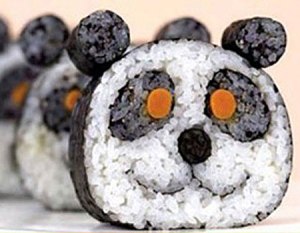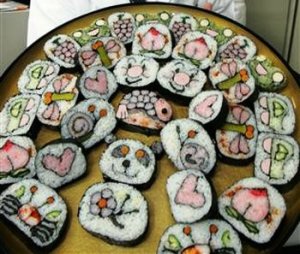Don’t try this. Its just for fun:)
Interesting videos about SUSHI
Some funny sushi designs
The Sushi Facts – Did you know ?
- Nearly half the fish consumed as food worldwide are raised on fish farms rather than caught in the wild, according to the Food and Agriculture Organization of the United Nations.
- The highest price ever paid for a sushi grade Bluefin Tuna was $396,000 for a 754 pound fish ($526/lb) on January 4th, 2011 at the Tsukiji Fish market in Tokyo. What makes this more interesting is that this record was 10 years to the day as the last record. Previously,the highest price ever paid for a sushi grade Bluefin Tuna was $173,600 for a 444 pound fish ($391/lb) on January 5th, 2001. (wow)
- Sushi traditionalists say the fish should never be raw—nor should it be completely fresh.
- Approximately 80% of the world’s bluefin tuna catch is used for sushi.
- Today’s sushi began as a type of fast food—the 19th-century Japanese equivalent of a McDonald’s drive-thru.
- The word “sushi” doesn’t refer to fish at all—it refers to rice that has been seasoned with vinegar, sugar, and salt.
- apanese usually eat miso soup not at the beginning of the meal, but at the end—to aid digestion.
- In Japan, an apprentice sushi chef spends two years learning to cook and season the rice, and another three learning to prepare fish, before he is allowed to work behind the sushi bar.
- Many sushi chefs believe that the customer eats not just with his mouth, but with his eyes. Preparing sushi is like creating a Zen garden.
- In today’s sushi, frozen fish is often “fresher” than fresh fish.
- The raw shrimp served in sushi all begin life as males—and then they all suddenly become females and have sex with their younger siblings.
What do you think? Do you think eating sushi too often is healthy?
Secrets Of Making delicious Sushi
Often, up to 80% of product consumed during a sushi meal is rice. Getting your sushi rice right is a crucial element in successful sushi making at home. The proper preparation of the rice is so important that in our shop as well as most quality establishments there are chefs whose sole responsibility is to cook the rice.
If you do not have a Japanese rice cooker, a heavy pot with lid is essential( I like Lagostina cookware). One secret is to always measure your ingredients carefully. Following is a basic sushi rice recipe for rolled sushi. Also, the type of rice you use is most important.
Your first step is to prepare your vinegar-water solution called tezu. Mix together 250 ml of water, 30 ml of rice vinegar (Marukan and Mitsukan are excellent) and 5 ml of salt.
(yields – 4 large rolls [futomaki] or 10 small rolls [hosomaki]) 500 ml Sushi Rice
600 ml Water
60 ml Rice Vinegar
30 ml Sugar
5 ml Salt
Wash the rice several times until the water runs fairly clear when draining. Let your wash rice strain for 30 minutes. Transfer the rice to your pot or Japanese electric rice cooker and add the measured water.
For electric rice cookers, turn on and wait for rice to finish cooking. For stove top cooking heat to boiling , cover tightly and simmer at lowest heat allowing the rice to steam for 18 minutes. You must leave it covered… no peaking!
Remove your pot from the heat and let stand covered for another 15 minutes.
Mix the vinegar, sugar and salt together in a small saucepan. Heat the mixture until the sugar dissolves, stirring frequently. Remove from heat and let your sushi vinegar cool to room temperature.
Take a wooden spatula or spoon and cut and fold the rice. Be gentle as you do not want to smash the cooked grains.
Moisten your bowl with a cloth dampened with your TEZU mixture. The traditional bowl to use is the flat-bottomed wooden sushi oke or hangiri. The porous wood absorbs excess moisture and the large surface allows the rice to cool more quickly and evenly.
Put the hot rice into your mixing bowl and add 1/4 of the sushi vinegar solution. Mix with a folding motion so as to not smash your perfect sushi rice. Repeat until all sushi vinegar is used.
After mixing, fan [electric fan will work] the hot rice mixture for about 5 or 6 minutes in order to remove excess moisture and create a glossy shine to your rice. Your rice should have a slight chewiness and be sticky to the touch.
Now you are done! 🙂
How to correctly eat sushi?
Is eating sushi healthy?
Sushi consists of rice and some other ingredients, often raw fish, but sometimes vegetables, cooked fish or other seafood. Originating in Japan, sushi is typically served with vinegar, soy sauce and wasabi, a spicy green condiment. Raw fish alone is known as sashimi and is another common dish at sushi restaurants. The fish used in sushi must be of high quality since it is often consumed raw.
Calories
Sushi tends to be made of low-calorie ingredients, so it is often a good food for weight loss. Vegetable rolls, also known as maki, and fish rolls, also known as nigiri, are your best bets for a low-calorie sushi meal. Some sushi dishes contain high-calorie additions, such as mayonnaise, so avoid these if possible. Also avoid deep-fried sushi rolls, such as spider rolls made of deep-fried soft-shelled crab.
Fats
Overall, most sushi is low in fat. If it contains seafood or fish, it may be a good source of omega-3 fatty acids, a type of polyunsaturated fat. Omega-3 fats exert a protective effect against cardiovascular disease. For this reason, the American Heart Association recommends consuming fish twice a week. Fatty fish such as salmon and albacore tuna have the highest levels of omega-3 fats.
Considerations
In general, sushi can be a healthy meal up to twice a week, but should be part of an overall healthy and balanced diet. Pregnant women and people with compromised immune systems may want to avoid sushi containing fish due to the possibility of parasites or microorganisms and the dangers of mercury contamination. However, these individuals, along with anyone who doesn’t eat fish or seafood for other reasons, may still choose from the wide variety of healthy sushi options made using vegetables, tofu or other ingredients.
Japan Sushi Chain Pays Record $1.76 Million for Tuna at Auction
Japan Sushi Chain Pays Record $1.76 Million for Tuna at Auction
Kiyomura K.K., a Tokyo-based sushi chain, paid a record 155.4 million yen ($1.76 million), almost triple last year’s amount, to outbid an affiliate of a Hong Kong-based rival at the Tsukiji market’s first 2013 auction.
Sushi School
Did you know there was a sushi school in California? see the link for more details.



